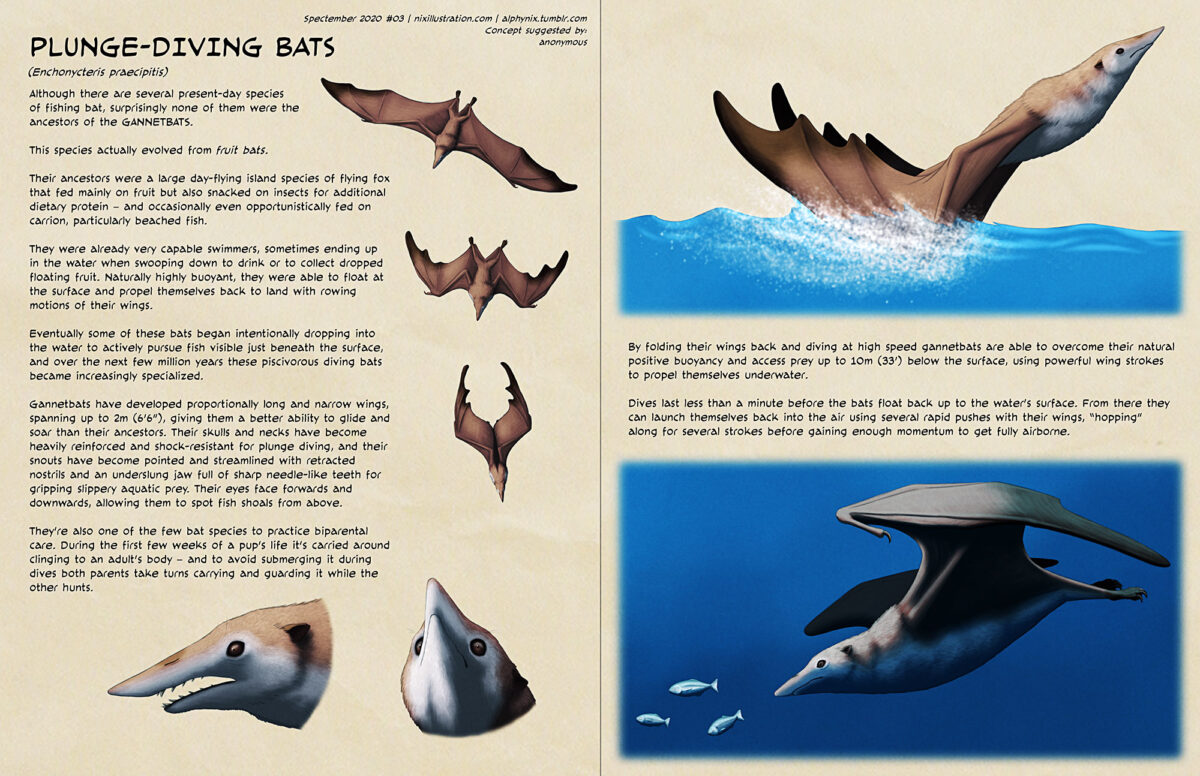Transcript for the text on the image under the cut:
PAGE 1
Spectember 2020 #03 | nixillustration.com | alphynix.tumblr.com
Concept suggested by:
anonymous
Plunge-Diving Bats
(Enchonycteris praecipitis)
Although there are several present-day species of fishing bat, surprisingly none of them were the ancestors of the GANNETBATS.
[Image: three views of a long-winged pointy-nosed bat folding its wings back and dropping headfirst into a plunge dive.]
This species actually evolved from fruit bats.
Their ancestors were a large day-flying island species of flying fox that fed mainly on fruit but also snacked on insects for additional dietary protein – and occasionally even opportunistically fed on carrion, particularly beached fish.
They were already very capable swimmers, sometimes ending up in the water when swooping down to drink or to collect dropped floating fruit. Naturally highly buoyant, they were able to float at the surface and propel themselves back to land with rowing motions of their wings.
Eventually some of these bats began intentionally dropping into the water to actively pursue fish visible just beneath the surface, and over the next few million years these piscivorous diving bats became increasingly specialized.
Gannetbats have developed proportionally long and narrow wings, spanning up to 2m (6’6”), giving them a better ability to glide and soar than their ancestors. Their skulls and necks have become heavily reinforced and shock-resistant for plunge diving, and their snouts have become pointed and streamlined with retracted nostrils and an underslung jaw full of sharp needle-like teeth for gripping slippery aquatic prey. Their eyes face forwards and downwards, allowing them to spot fish shoals from above.
They’re also one of the few bat species to practice biparental care. During the first few weeks of a pup’s life it’s carried around clinging to an adult’s body – and to avoid submerging it during dives both parents take turns carrying and guarding it while the other hunts.
[Image: two different close up views of the head of a gannetbat, showing its narrow pointed snout, needle-like teeth, and downwards-facing eyes.]
PAGE 2
[Image: a gannet bat using its wings to launch itself into the air from the water’s surface.]
By folding their wings back and diving at high speed gannetbats are able to overcome their natural positive buoyancy and access prey up to 10m (33’) below the surface, using powerful wing strokes to propel themselves underwater.
Dives last less than a minute before the bats float back up to the water’s surface. From there they can launch themselves back into the air using several rapid pushes with their wings, “hopping” along for several strokes before gaining enough momentum to get fully airborne.
[Image: a gannetbat swimming underwater, chasing several small fish.]

